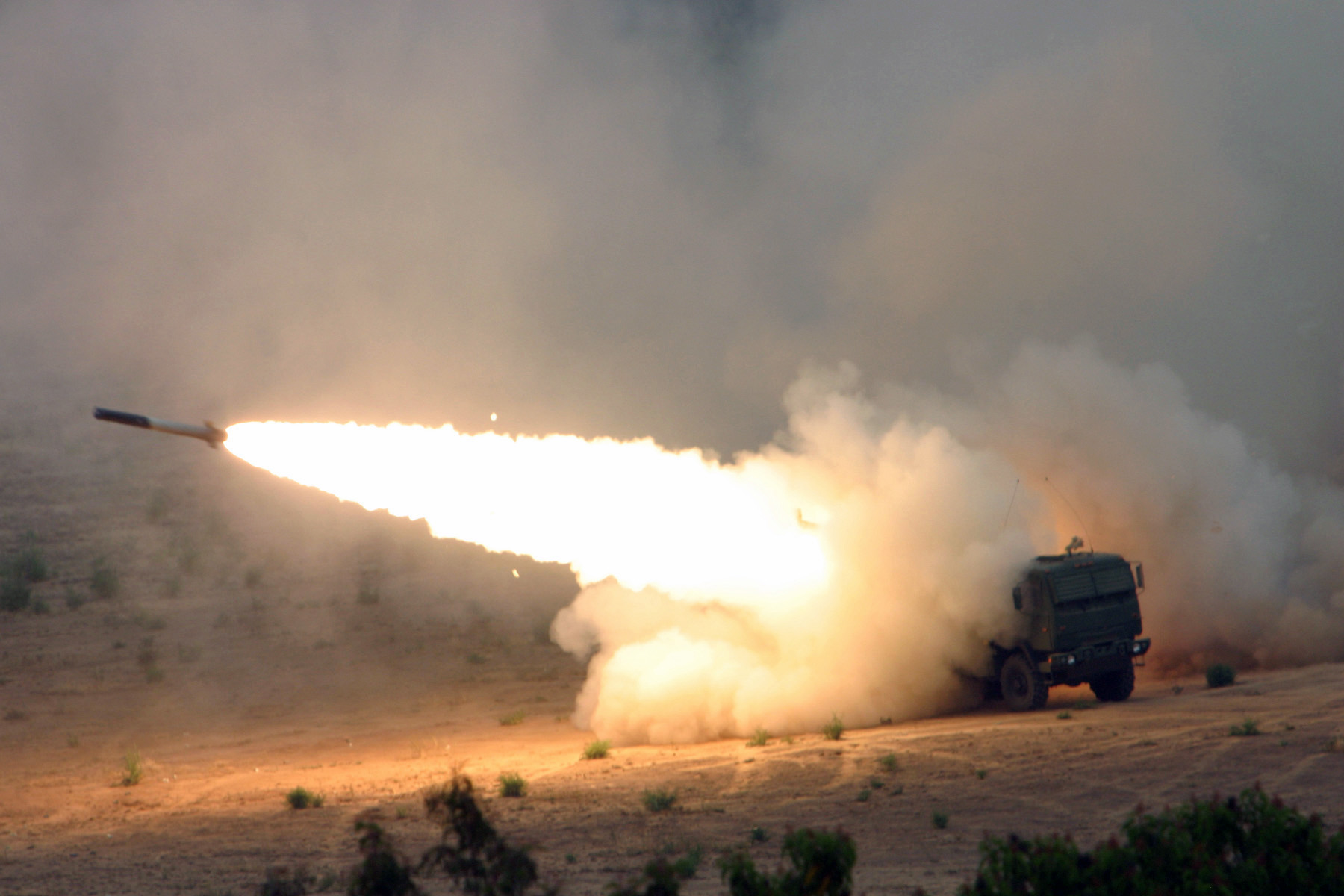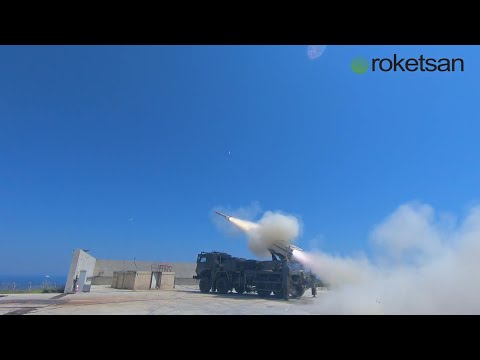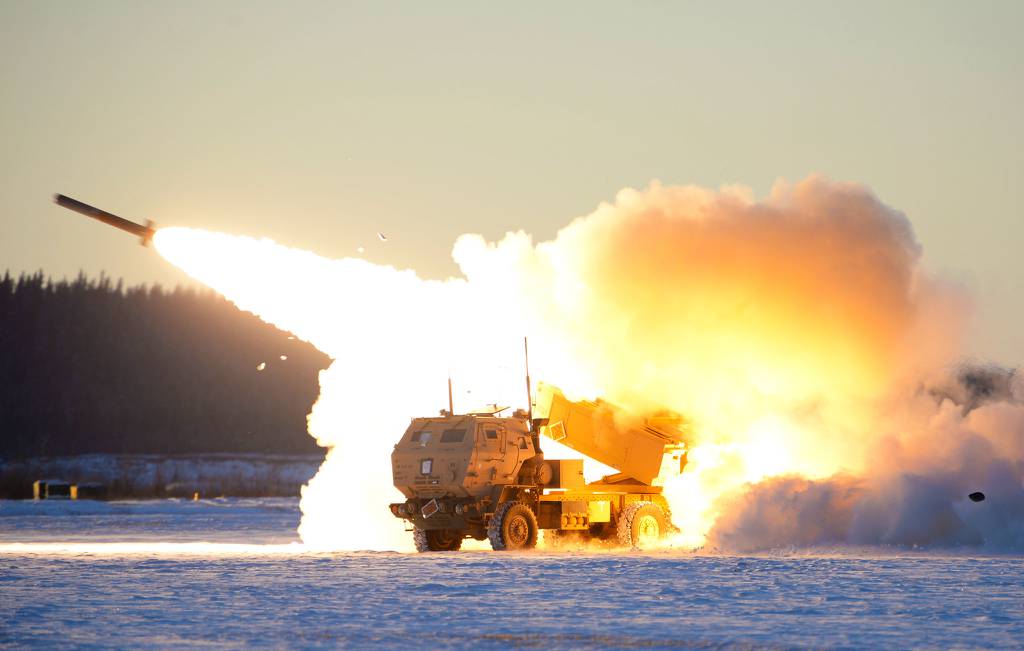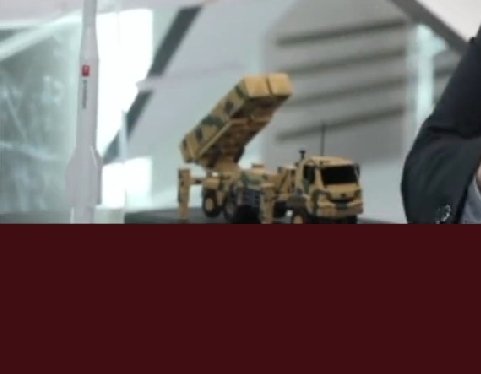hope this has something to do with ballistic missile defence.A memorandum of understanding was signed between TÜBİTAK SAGE and RWM Italia.
TÜBİTAK SAGE announced that a memorandum of understanding was signed with RWM Italia, a subsidiary of German Rheinmetall, on explosives and bombs.
Latest Thread
You are using an out of date browser. It may not display this or other websites correctly.
You should upgrade or use an alternative browser.
You should upgrade or use an alternative browser.
‘Better’ Than HIMARS, Ukraine Gets New Laser-Guided MLRS From From Turkey That Can Even Strike Moving Targets
By Sakshi Tiwari - December 1, 2022Turkey had armed Ukraine with its TRLG-230 Multiple Launch Rocket System. With social media flooded with what appears to be the first use of the rocket in combat, all eyes are now on this laser-guided MLRS that could not only complement HIMARS but also outperform them.
The information about the transfer of TRLG-230 MLRS was first publicized by open-satellite intelligence tracker Oryx, citing some unknown Ukrainian Defense Ministry officials.
Soon after the revelation, an unverified video clip that purportedly recorded Ukraine’s first-ever use of the TRLG-230 system went viral on social media.
The video shows only one projectile fired by a launcher with no information on the launch time or location. Ukraine has not officially acknowledged the clip or the claims.
However, one of the most intriguing facts about this is that the Turkish Multi-Barrel Rocket Launcher system (MBRLS) manufactured by Roketsan is mounted on Russian-made Kamaz-65224 6×6 truck chassis.
The reported use of the system comes at a time when Russia is hell-bent on obliterating Ukraine’s energy infrastructure amid a very harsh winter.
It is believed to be Ukraine’s most significant Turkish aid after the combat success of Bayraktar TB2 drones. The TB2s helped Ukraine make up for its power differential with the invading forces and helped conduct several successful offensives.

The Roketsan MBRLs and TRLG-230 rockets would be a critical addition to Ukraine’s arsenal to combat the Russian onslaught that continues to shell territories reoccupied by Kyiv. Ukraine currently employs the HIMARS, MLRS 270, and MARS II MLRS for long-range strikes on the invading troops.
TRLG-230 rockets are similar to the 227mm M30/M31 Guided Multiple Launch Rocket System (GMLRS) rockets received from the US and others for use with the HIMARS and variants of the M270 Multiple Launch Rocket System.
However, the TRLG-230s include a laser seeker that allows them to engage dynamic targets – a capability not available with HIMARS and MLRS 270 operational in Ukraine.
Turkiye delivered 230-mm MLRS TRLG-230 to Ukraine
The TRLG-230’s use by Ukraine also comes at an opportune time as Russia has started to reportedly outrange the HIMARS by deploying its own Tornado-S MLRS to the frontlines.
While the Russian Tornado-S has a significantly longer range of 120 kilometers, the Turkish TRLG-230 has unmatched precision owing to a laser seeker mounted on the nose of the projectile.
Besides, the transfer of this laser-guided system will help ease the burden on Washington, which has supplied dozens of HIMARS and is being warned about its depleting stockpiles.
TRLG-230 Is A Game Changer?
The Multiple Launch Rocket Systems like the M142 High Mobility Artillery Rocket System (HIMARS) supplied by the US and the MLRS 270 provided by the UK proved to be game changers for Ukraine and armed the country with long-range firing capabilities.These systems essentially slowed the Russian march and tilted the battle in Kyiv’s favor by allowing it to strike military facilities, fuel depots, ammo storage, etc., inside the Russian territory.
The impact was such that after the Ukrainian troops liberated Kherson, Ukrainian President Zelensky thanked the HIMARS for his symbolic visit to the region.
However, the TRLG-230 is believed to add more teeth to the capability of the Ukrainian forces with a valuable extra precision-guided stand-off attack capability. This will be in addition to the HIMARS and M270 MLRS already widely deployed by the Ukrainian troops.
The M30/M31 rockets used in these launchers have a maximum range similar to the TRLG-230 but only GPS-assisted Inertial Navigation System (INS) guidance. In contrast, the TRLG-230 has laser-seekers.
Because of their laser guidance capability, the TRLG-230s can strike moving targets. These rockets have high-explosive blast-fragmentation warheads and can be equipped with proximity fuzes, enhancing their capacity to engage moving targets. According to Roketsan, when deployed in laser-guided mode, they are also simply more accurate.
In addition, the MRLS is supposed to work more effectively when combined with the TB-2 Bayraktar drones to identify, coordinate and engage its rocket artillery fire on ground targets, as noted by EurAsian Times.
According to Oryx, the TB-2 can only hit four targets and has 24-hour endurance and a 75-kilometer range Electro-Optical/Infrared (EO/IR) system, which the 230mm TRLG-230 takes advantage of.
Footage released by the Azerbaijani military last year revealed that Baku had used TRLG-230s in the 2020 conflict in Nagorno-Karabakh, which also saw the rise of the TB-2.

The Roketsan’s website says the Management System of the battery can be integrated with modern fire support automation [tactical fire direction system] and battlefield command-control and management systems.
Target acquisition radars or unmanned aerial vehicles supply target information to the battery. The Ukrainian military employs a variety of counter-battery radars that can be exploited to maximum advantage.
According to unnamed individuals familiar with the transfer, Turkey has already provided at least 50 TRLG-230 rockets and an indeterminate number of mobile launchers to the Ukrainian military. These weapons have been used in combat.
Other unsubstantiated sources claim that up to 200 rockets and eight launchers were deployed to Ukraine. It is unclear if the launchers and rockets were provided as military aid or as a straight sale.
The transfer of such a sophisticated system to Kyiv by Ankara could create some rift in the already-complicated relationship between Turkey and Russia. Turkey has launched a barrage of airstrikes on suspected militant targets in northern Syria and Iraq over the past week, a move Russia disapproves of.

'Better' Than HIMARS, Ukraine Gets New Laser-Guided MLRS From From Turkey That Can Even Strike Moving Targets
Turkey has armed Ukraine with its TLRG-230 Multiple Launch Rocket System. All eyes are now laser-guided MLRS that even tops HIMARS MLRS
 eurasiantimes.com
eurasiantimes.com
Good, but didn’t Roketsan developed a laser guided missile with twice the range of TRLG 230 ? Would be a huge plus if they sent it as well.
Baryshx
Contributor
I didn't believe it when I first saw this news, I still don't. Why are we so comfortable in Ukraine but holding ourselves back in Syria? Where do the USA and Russia come from, but we cannot intervene in the country next to us.‘Better’ Than HIMARS, Ukraine Gets New Laser-Guided MLRS From From Turkey That Can Even Strike Moving Targets
By Sakshi Tiwari - December 1, 2022
Turkey had armed Ukraine with its TRLG-230 Multiple Launch Rocket System. With social media flooded with what appears to be the first use of the rocket in combat, all eyes are now on this laser-guided MLRS that could not only complement HIMARS but also outperform them.
The information about the transfer of TRLG-230 MLRS was first publicized by open-satellite intelligence tracker Oryx, citing some unknown Ukrainian Defense Ministry officials.
Soon after the revelation, an unverified video clip that purportedly recorded Ukraine’s first-ever use of the TRLG-230 system went viral on social media.
The video shows only one projectile fired by a launcher with no information on the launch time or location. Ukraine has not officially acknowledged the clip or the claims.
However, one of the most intriguing facts about this is that the Turkish Multi-Barrel Rocket Launcher system (MBRLS) manufactured by Roketsan is mounted on Russian-made Kamaz-65224 6×6 truck chassis.
The reported use of the system comes at a time when Russia is hell-bent on obliterating Ukraine’s energy infrastructure amid a very harsh winter.
It is believed to be Ukraine’s most significant Turkish aid after the combat success of Bayraktar TB2 drones. The TB2s helped Ukraine make up for its power differential with the invading forces and helped conduct several successful offensives.
HIMARS photographed while firing a rocket-Wikimedia Commons
The Roketsan MBRLs and TRLG-230 rockets would be a critical addition to Ukraine’s arsenal to combat the Russian onslaught that continues to shell territories reoccupied by Kyiv. Ukraine currently employs the HIMARS, MLRS 270, and MARS II MLRS for long-range strikes on the invading troops.
TRLG-230 rockets are similar to the 227mm M30/M31 Guided Multiple Launch Rocket System (GMLRS) rockets received from the US and others for use with the HIMARS and variants of the M270 Multiple Launch Rocket System.
However, the TRLG-230s include a laser seeker that allows them to engage dynamic targets – a capability not available with HIMARS and MLRS 270 operational in Ukraine.
Turkiye delivered 230-mm MLRS TRLG-230 to Ukraine
The TRLG-230’s use by Ukraine also comes at an opportune time as Russia has started to reportedly outrange the HIMARS by deploying its own Tornado-S MLRS to the frontlines.
While the Russian Tornado-S has a significantly longer range of 120 kilometers, the Turkish TRLG-230 has unmatched precision owing to a laser seeker mounted on the nose of the projectile.
Besides, the transfer of this laser-guided system will help ease the burden on Washington, which has supplied dozens of HIMARS and is being warned about its depleting stockpiles.
TRLG-230 Is A Game Changer?
The Multiple Launch Rocket Systems like the M142 High Mobility Artillery Rocket System (HIMARS) supplied by the US and the MLRS 270 provided by the UK proved to be game changers for Ukraine and armed the country with long-range firing capabilities.
These systems essentially slowed the Russian march and tilted the battle in Kyiv’s favor by allowing it to strike military facilities, fuel depots, ammo storage, etc., inside the Russian territory.
The impact was such that after the Ukrainian troops liberated Kherson, Ukrainian President Zelensky thanked the HIMARS for his symbolic visit to the region.
However, the TRLG-230 is believed to add more teeth to the capability of the Ukrainian forces with a valuable extra precision-guided stand-off attack capability. This will be in addition to the HIMARS and M270 MLRS already widely deployed by the Ukrainian troops.
The M30/M31 rockets used in these launchers have a maximum range similar to the TRLG-230 but only GPS-assisted Inertial Navigation System (INS) guidance. In contrast, the TRLG-230 has laser-seekers.
Because of their laser guidance capability, the TRLG-230s can strike moving targets. These rockets have high-explosive blast-fragmentation warheads and can be equipped with proximity fuzes, enhancing their capacity to engage moving targets. According to Roketsan, when deployed in laser-guided mode, they are also simply more accurate.
In addition, the MRLS is supposed to work more effectively when combined with the TB-2 Bayraktar drones to identify, coordinate and engage its rocket artillery fire on ground targets, as noted by EurAsian Times.
According to Oryx, the TB-2 can only hit four targets and has 24-hour endurance and a 75-kilometer range Electro-Optical/Infrared (EO/IR) system, which the 230mm TRLG-230 takes advantage of.
Footage released by the Azerbaijani military last year revealed that Baku had used TRLG-230s in the 2020 conflict in Nagorno-Karabakh, which also saw the rise of the TB-2.

The Roketsan’s website says the Management System of the battery can be integrated with modern fire support automation [tactical fire direction system] and battlefield command-control and management systems.
Target acquisition radars or unmanned aerial vehicles supply target information to the battery. The Ukrainian military employs a variety of counter-battery radars that can be exploited to maximum advantage.
According to unnamed individuals familiar with the transfer, Turkey has already provided at least 50 TRLG-230 rockets and an indeterminate number of mobile launchers to the Ukrainian military. These weapons have been used in combat.
Other unsubstantiated sources claim that up to 200 rockets and eight launchers were deployed to Ukraine. It is unclear if the launchers and rockets were provided as military aid or as a straight sale.
The transfer of such a sophisticated system to Kyiv by Ankara could create some rift in the already-complicated relationship between Turkey and Russia. Turkey has launched a barrage of airstrikes on suspected militant targets in northern Syria and Iraq over the past week, a move Russia disapproves of.

'Better' Than HIMARS, Ukraine Gets New Laser-Guided MLRS From From Turkey That Can Even Strike Moving Targets
Turkey has armed Ukraine with its TLRG-230 Multiple Launch Rocket System. All eyes are now laser-guided MLRS that even tops HIMARS MLRSeurasiantimes.com
Currently, that missile is not on sale and I don't expect it to be soon. Turkiye doesn't sell some of its defense products. SSB president only mentioned it once or twice.Good, but didn’t Roketsan developed a laser guided missile with twice the range of TRLG 230 ? Would be a huge plus if they sent it as well.
İf we had nuclear warheads, NEB with nukes would be ecosystem friendly great weapon.
Tübitak Sage Manager Gürcan Okumuş stated that they are working on versions of NEB-84 that can drill 3-4 meters of concrete. The NEB-84 can currently drill 2.1+ meters thick 35 MPa reinforced concrete.

The 6x6 BMC chassis has now become the dual-mode Bora launcher. It used to be the only one.
Can you find the video or anything if that news.I saw on news just recently with a picture of exact rpg warhead that Turkey started to produce it. You know, rpg is not able to stop tanks anymore, i thought this is developed to have bigger warhead to stop at least ifv
What is the effective range?
I wondered why OMTAS attacks at like 60 degrees or a high diver?
The answer is:
Sweet! Now to fix those manufacturing woes and ramp up those production numbers!I wondered why OMTAS attacks at like 60 degrees or a high diver?
The answer is:
Last edited by a moderator:
Not with this videoDo we know the angle of attack of karaok? Is it possible to make an estimation from test video? Hexciter?
It probably has the same range as the Hisar-O RF. As I understand it, the corrosion resistance of the parts has been increased just to adapt to the marine environment.What is the effective range?
Yes, I expect two more big surprises for the land-based Atmaca 2023, ready for mass production before the end of the year, one in the rocket and missile range and the other in the Hürjet, if it catches up there might be a little surprise.
From Atmaca IIR test.
Turkey really need to start working on it, it can develop a new ballistic rocket, or a new sdb can fit in 230mmdo we have something like this?





